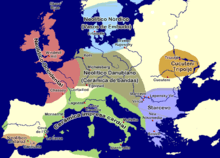Starčevo–Kőrös–Criș culture
 | |
| Alternative names | Starčevo–Körös–Criș |
|---|---|
| Period | Neolithic Europe |
| Dates | circa 5,800 B.C.E. — circa 4,500 B.C.E. |
| Type site | Starčevo |
| Preceded by | Mesolithic Romania, Neolithic Greece |
| Followed by | Gumelnița–Karanovo culture |
The Starčevo–Körös culture[1] or Starčevo–Körös–Criş culture[2] is a grouping of three related Neolithic archaeological cultures in Southeastern Europe: the Starčevo culture, the Körös culture, and the Criş culture.
- The Starčevo culture is an archaeological culture of Southeastern Europe, in what is now Serbia, dating to the Neolithic period between c. 5500 and 4500 BCE[3] (according to other source, between 6200 and 5200 BCE).[4] The Starčevo culture is sometimes grouped together and sometimes not.[5]
- The Körös culture is another Neolithic archaeological culture, but in Central Europe, that was named after the river Körös in eastern Hungary.[6]
- The Criş culture, in what is now Romania, survived from about 5800 to 5300 BC, and is the same culture as Körös. The different names for the two stem from different names for the same river. The river named Körös in Hungary becomes the Criş river in Romania.[6]
References
- ↑ Tringham 2014; Whittle 2003; Thorpe 2003; Milisauskas 2002; Barker 1985
- ↑ Shaw & Jameson 2002
- ↑ Istorijski atlas, Intersistem Kartografija, Beograd, 2010, page 11.
- ↑ Chapman, John (2000). Fragmentation in Archaeology: People, Places, and Broken Objects. London: Routledge. p. 237. ISBN 978-0-415-15803-9. .
- ↑ Vojislav Trbuhović, Indoevropljani, Beograd, 2006, page 62.
- 1 2 The Körös culture
Sources
- Ruth Tringham (13 November 2014). Hunters, Fishers and Farmers of Eastern Europe, 6000-3000 B.C. Routledge. pp. 80–. ISBN 978-1-317-59946-3.
- Ian Shaw; Robert Jameson (6 May 2002). A Dictionary of Archaeology. John Wiley & Sons. pp. 541–. ISBN 978-0-631-23583-5.
- Alisdair Whittle (2 September 2003). The Archaeology of People: Dimensions of Neolithic Life. Routledge. pp. 136–. ISBN 978-1-134-40982-2.
- Graeme Barker (11 July 1985). Prehistoric Farming in Europe. CUP Archive. pp. 90–. ISBN 978-0-521-22810-7.
- Sarunas Milisauskas (2002). European Prehistory: A Survey. Springer Science & Business Media. pp. 155–. ISBN 978-0-306-46793-6.
- I. J. Thorpe (2 September 2003). The Origins of Agriculture in Europe. Routledge. pp. 29–. ISBN 978-1-134-62009-8.
Further reading
- Biagi, P. and Spataro, M., 2005. New observations on the radiocarbon chronology of the Starčevo-Criş and Körös cultures. Prehistoric Archaeology & Anthropological Theory and Education. Reports of Prehistoric Research Projects, pp. 6–7.
- Kertész, R., Sümegi, P. 2001. Theories, critiques and a model: Why did the expansion of the Körös–Starcevo culture stop in the centre of the Carpathian Basin. Kertész, R.–Makkay, J. eds. From the Meoslithic to the Neolithic. Archaeolinqua Press, Budapest, pp. 225–246.
- KOZŁOWSKI, J.K. and RACZKY, P., 2010. Neolithization of the Carpathian Basin: Northernmost distribution of the Starčevo/Körös culture. Polska Akademia Umiejetnosci, Kraków.
- Ursulescu, N., 2001. Local variants of the Starčevo-Criş culture in the Carpato-Nistrean area. Festschrift für Gh. Lazarovici. Timişoara: Muzeul Banatului, pp. 59–67.
- El Susi, G., 2008. The comparative analyze of faunal samples from Sites dated in Starčevo-Körös-Criş Culture–phases IB-IIA from Transylvania and Banat.
- Spataro, M., 2004. Differences and similarities in the pottery production of the Early Neolithic Starcevo-Criş and Impressed Ware Cultures. Rivista di Scienze Preistoriche, 57, pp. 321–336.
- Letica, Z., 1971. Starčevo and Körös culture at Vinča. Archaeologia Iugoslavica IX, pp. 11–18.
- Jongsma, T.L., 1997. Distinguishing pits from pit houses: an analysis of architecture from the Early Neolithic central Balkan Starčevo-Criş culture through the analyses of daub distribution. Unpublished MA thesis, University of Manitoba, Department of Anthropology.
- Beldiman, C. and Sztancs, D.M., 2013. The osseous artefacts of the Starčevo-Criş culture in Romania. An overview. In Facets of the Past. The Challenge of the Balkan Neo-Eneolithic. Proceedings of the International Symposium Celebrating the 85th Birth Anniversary of Eugen Comşa, 6–12 October 2008 (pp. 106–133). Editura Academiei Române Bucureşti.
- Beldiman, C. and Diana-Maria, S., 2011. Technology of Skeletal Materials of the Starčevo-Criş Culture in Romania. The First Neolithic Sites in Central/South-East European Transect, 2, pp. 57–70.
External links
| Wikimedia Commons has media related to Starčevo culture. |
This article is issued from
Wikipedia.
The text is licensed under Creative Commons - Attribution - Sharealike.
Additional terms may apply for the media files.